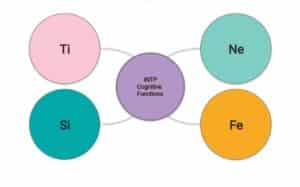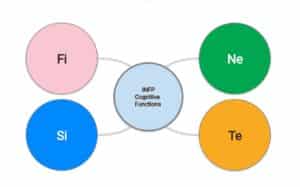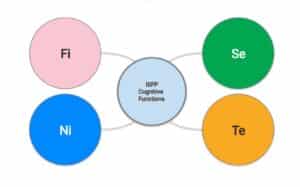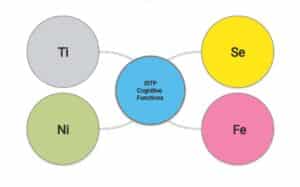Reading Time: 20 Minutes
When we talk about ESFPs, most people think of them as the fun-loving, life-of-the-party types. And while that’s true, there’s a lot more going on under the surface. At the core of their personality are the ESFP cognitive functions, which are the building blocks of how they see the world, make decisions, and interact with others.
These functions—Extraverted Sensing (Se), Introverted Feeling (Fi), Extraverted Thinking (Te), and Introverted Intuition (Ni)—work together in unique ways to shape who ESFPs are. Understanding these functions gives us a clearer picture of what makes ESFPs tick and why they bring so much energy and warmth to our lives.
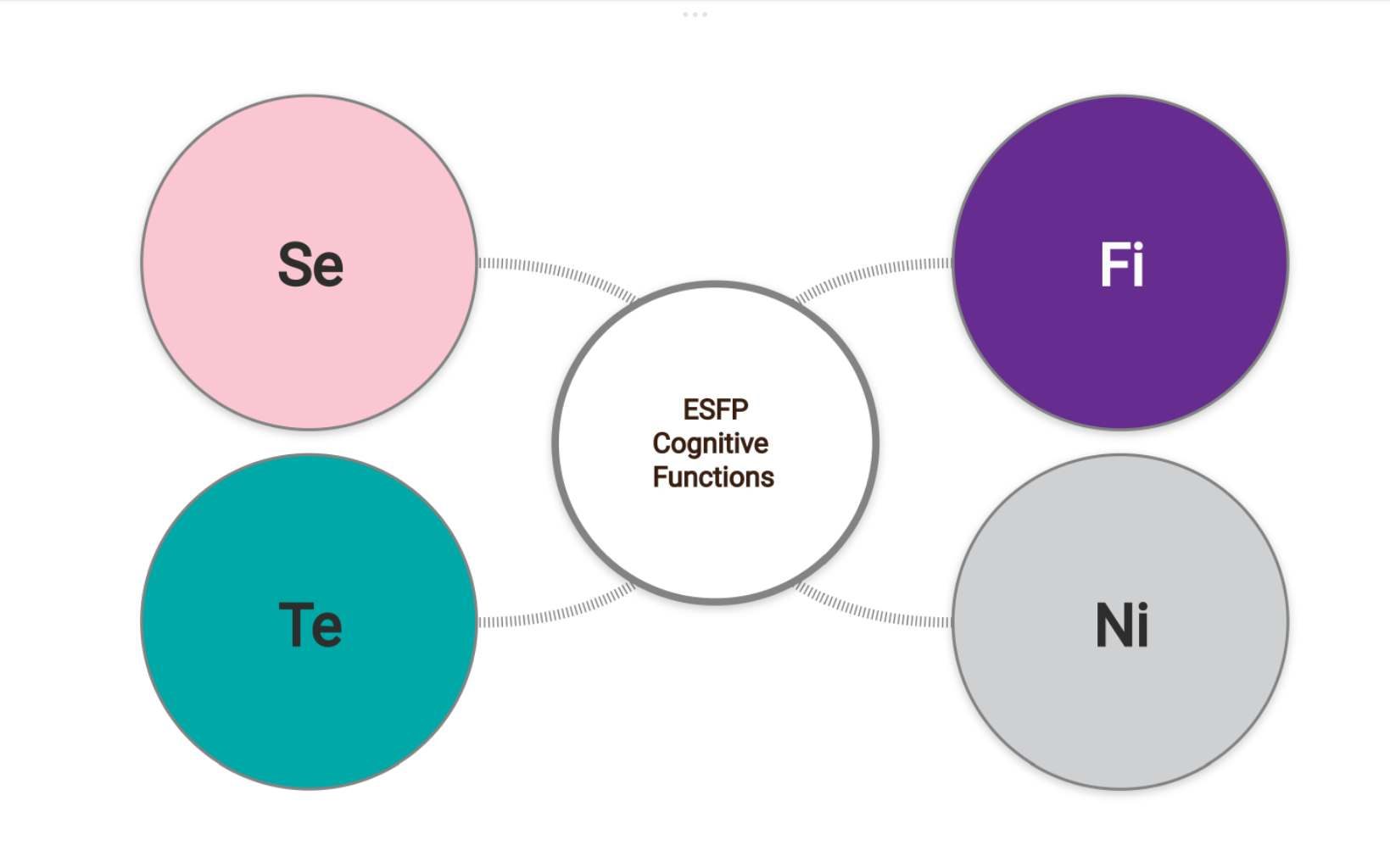
The ESFP Cognitive Functions
1. The Dominant Function: Extraverted Sensing (Se)
When it comes to ESFPs, their world revolves around the here and now, thanks to their dominant function, Extraverted Sensing, or Se for short. Think of Se as their personal radar, always tuned in to what’s happening around them. ESFPs are the ones who notice the smallest details, like the pattern on your shirt or the exact moment the beat drops at a party. They don’t just see the world; they dive headfirst into it, soaking up every bit of sensory information like a sponge.
This focus on the present moment means ESFPs are fantastic at living life to the fullest. They’re the ones who will suggest a spontaneous road trip or try that new restaurant nobody’s heard of yet. They experience life with all their senses on high alert, making them incredibly in tune with their surroundings. While others might be lost in thought, ESFPs are busy experiencing life as it happens, right down to the taste of their coffee and the feel of the sun on their skin.
Of course, there’s a flipside to being so present-focused. Long-term planning? Not exactly their forte. ESFPs might struggle with things that require them to think ten steps ahead because they’re too busy enjoying step one. But let’s be honest, who’s got time to worry about tomorrow when there’s so much to do today?
2. The Auxiliary Function: Introverted Feeling (Fi)
Now, while ESFPs are busy soaking up everything around them, they’ve also got a rich internal world thanks to their auxiliary function, Introverted Feeling, or Fi. Fi acts like their personal moral compass, guiding them in making decisions based on what feels right deep down. While they might not always voice their inner values, trust that they’re there, influencing everything from the friendships they form to the causes they support.
Fi is all about staying true to oneself. ESFPs use this function to figure out what really matters to them on a personal level. Whether it’s their stance on a social issue or their choice in friends, Fi ensures they’re not just following the crowd. It’s like their secret vault of personal values—quiet, but solid as a rock.
But, like any good thing, Fi comes with its challenges. ESFPs might sometimes find themselves caught between their desire to live in the moment (Se) and their need to stay true to their inner values (Fi). This can lead to inner conflict, especially if what’s happening around them doesn’t align with what feels right on the inside. Navigating this tug-of-war between external excitement and internal values is part of the ESFP’s growth journey, and it’s what makes them such a complex and interesting personality type.
3. The Tertiary Function: Extraverted Thinking (Te)
As ESFPs grow and develop, their Extraverted Thinking, or Te, starts to play a more significant role. Te is like the organizing force in their lives, helping them to structure their world and get things done. Think of it as the little voice that occasionally pops up to say, “Hey, maybe we should make a plan.” It’s what helps ESFPs put their ideas into action and manage the more practical aspects of life.
Te is all about efficiency and logic. When ESFPs tap into this function, they can surprise everyone (including themselves) by how effectively they can organize events, manage tasks, or even lead a project. Te gives them the ability to break down big goals into manageable steps, making things happen in the real world. It’s the reason why some ESFPs can go from “Let’s throw a party!” to actually pulling off an amazing event that people talk about for months.
However, since Te is not as naturally strong as Se or Fi, ESFPs might not rely on it as often. They tend to use it when they really need to get something done, but it’s not always their first instinct. Developing Te is a bit like exercising a muscle; the more they use it, the stronger it gets. Over time, ESFPs learn to balance their spontaneous side with a bit of practical planning, making them not just fun but also surprisingly dependable.
4. The Inferior Function: Introverted Intuition (Ni)
Last but not least, we have Introverted Intuition, or Ni, the trickiest of the bunch for ESFPs. Ni is like a faint whisper in the back of their minds, hinting at future possibilities and long-term patterns. While ESFPs are usually focused on the present, Ni occasionally nudges them to think about the big picture. It’s the part of them that asks, “Where is all this heading?” but because it’s their inferior function, it doesn’t always speak up very loudly.
Ni can be a bit mysterious for ESFPs. They’re so busy enjoying the moment that thinking about what lies ahead doesn’t come naturally. However, when they do tap into Ni, it can give them powerful insights into their future and help them make more informed decisions. It’s like catching a glimpse of the road ahead in the fog—brief and sometimes confusing, but important nonetheless.
During stressful times, Ni can show up in ways that aren’t always helpful. ESFPs might find themselves worrying about the future or overthinking decisions, something that’s out of character for their typically carefree nature. But as they mature, learning to embrace Ni can help ESFPs become more well-rounded, balancing their love for the present with a bit of future foresight.
In the end, ESFPs are like a vibrant tapestry woven from these four cognitive functions. They bring energy and excitement to everything they do, all while staying true to themselves and learning to balance their natural tendencies with the complexities of life. Understanding these cognitive functions gives us a clearer picture of what makes ESFPs tick and why they’re such a unique and valuable part of the world.
You Might Like To Read: INTP Cognitive Functions (Ti, Ne, Si, Fe): 4 Functions Explained in Very Simple Manner
The Dynamic Interaction of ESFP Cognitive Functions
Let’s talk about how these four cognitive functions—Extraverted Sensing (Se), Introverted Feeling (Fi), Extraverted Thinking (Te), and Introverted Intuition (Ni)—work together in the ESFP personality. Think of these functions as a team, each with its own job, but they all come together to make sure the ESFP gets through life with a smile on their face and maybe a dance in their step.
First up, we’ve got Se, the life of the party. Se is in the driver’s seat most of the time, guiding the ESFP toward exciting experiences and making sure they’re fully engaged in whatever’s happening around them. Whether it’s trying new foods, meeting new people, or simply soaking up the atmosphere, Se is always there, making sure the ESFP lives life to the fullest. But Se doesn’t work alone; it relies on the support of the other functions to keep everything balanced.
Enter Fi, the heart of the operation. Fi might not be as loud as Se, but it’s just as important. While Se is out there having fun, Fi is quietly making sure that everything the ESFP does aligns with their personal values. It’s like the wise friend who gently reminds you to stay true to yourself, even when things get wild. Together, Se and Fi create a balance between enjoying the present moment and staying authentic, making sure the ESFP’s actions reflect who they really are.
Now, every good team needs someone to keep things organized, and that’s where Te comes in. Te is the one who steps in when things need a bit of structure. Say the ESFP decides to throw a party. Se is all about picking the best music and making sure everyone’s having a great time, but Te is the one who makes sure there’s enough food, that the invitations go out on time, and that the cleanup afterward isn’t a total disaster. Te might not always be in charge, but when it steps up, it ensures everything runs smoothly, turning the ESFP’s fun ideas into reality.
Finally, we have Ni, the quiet observer of the group. Ni doesn’t get much airtime, but when it does speak up, it brings a sense of foresight and intuition. It’s like that moment when the ESFP suddenly realizes that all this fun has to lead somewhere and starts thinking about what the future might hold. Ni is the one who whispers, “Hey, maybe we should think about where this is going,” offering insights that might not always be obvious but are definitely worth considering. Though it’s the most underdeveloped of the functions, Ni adds depth to the ESFP’s otherwise present-focused mindset.
So, how do these functions interact? Well, it’s like a well-rehearsed dance. Se leads with energy and excitement, Fi keeps things meaningful, Te adds a bit of order, and Ni occasionally chimes in with a glimpse of what’s ahead. Together, they create a dynamic, vibrant personality that’s always ready for new experiences but with enough depth and balance to keep things from getting too chaotic.
But, like any team, sometimes there’s a bit of conflict. For instance, Se might want to go all out with spontaneous plans, but Fi might pull back if those plans don’t align with the ESFP’s values. Or, Te might push for a more structured approach to life, while Se just wants to keep things flexible and fun. And when Ni makes an appearance, it might cause a bit of anxiety, especially if the future looks uncertain.
Over time, as ESFPs grow and develop, they learn to juggle these functions more effectively. They start to understand when to lean on each one, creating a more balanced approach to life. This makes them not just the fun and energetic people they’re known for but also thoughtful, grounded, and surprisingly insightful when the moment calls for it.
In the end, the dynamic interaction of these cognitive functions is what makes ESFPs such a unique blend of excitement, authenticity, and occasional flashes of wisdom. It’s what allows them to bring so much joy and spontaneity into the world while still staying true to who they are at their core.
Common Misconceptions About ESFP Cognitive Functions
Now, let’s clear up some of the myths and misunderstandings about ESFPs and how their cognitive functions actually work. People often get the wrong idea about ESFPs because they focus on what’s on the surface and miss the deeper layers. Let me tell you, there’s a lot more to these folks than just being the life of the party.
One of the biggest misconceptions is that ESFPs are shallow or only interested in having fun. Sure, ESFPs love a good time—that’s a given. But just because they’re often the first ones to suggest a spontaneous road trip or hit the dance floor doesn’t mean they don’t think deeply about life. Their dominant function, Extraverted Sensing (Se), does drive them to live in the moment, but their auxiliary function, Introverted Feeling (Fi), adds a lot of depth to their personalities.
Fi makes sure they’re not just floating through life without a purpose; it’s their internal compass that helps them navigate the world according to their values. So, while it might seem like they’re all about the present, there’s a rich inner world guiding those actions.
Another common myth is that ESFPs can’t be organized or focused on long-term goals. People see their spontaneous nature and assume they must be all over the place. But here’s the thing: ESFPs do have the capability to plan and achieve goals, thanks to their Extraverted Thinking (Te) function. Te helps them get things done when they put their minds to it, and you’d be surprised at how efficiently they can pull off tasks when they decide to. It’s just that they prefer to keep things flexible and fun, so they don’t always rely on Te unless they need to.
And then there’s the assumption that ESFPs don’t think about the future. While it’s true that they’re more focused on the here and now, their Introverted Intuition (Ni), even though it’s their inferior function, does make an appearance from time to time. When it does, ESFPs can tap into their intuition and think ahead, even if it’s not their default mode. So, don’t be too quick to label them as short-sighted; they can surprise you with their insights when the situation calls for it.
Practical Applications of Understanding ESFP Cognitive Functions
Understanding how ESFP cognitive functions work isn’t just interesting trivia—it can actually make a big difference in how you relate to them, whether you’re a friend, partner, or coworker. Let’s break it down into a few areas where this knowledge really comes in handy.
First off, in relationships, knowing about these cognitive functions can help you connect with ESFPs on a deeper level. Since their dominant function is Se, ESFPs thrive on shared experiences. They love it when you join them in their adventures or show appreciation for the little things they notice about the world.
But don’t forget their Fi function; they appreciate genuine connections that respect their personal values. If you can align with what they care about, you’re golden. Plus, understanding that they might sometimes struggle with long-term planning (thanks to that tricky Ni) can help you be more patient and supportive when it’s time to talk about the future.
In the workplace, knowing an ESFP’s cognitive functions can be a game-changer. ESFPs bring energy and creativity to any team, but they might need a bit of help staying on track with more routine or long-term tasks. This is where you can step in to provide structure or deadlines, which helps them activate their Te function.
When you give them the space to bring their ideas to life while also offering a bit of guidance, you’ll see just how effective they can be. ESFPs excel in roles that allow them to interact with people, use their creativity, and see immediate results from their efforts. Careers in event planning, marketing, or any hands-on job are perfect fits because they can use their Se to the fullest while relying on their other functions to get things done.
So, whether you’re trying to understand an ESFP friend better or work alongside one in a professional setting, knowing how their cognitive functions interact gives you the tools to support and appreciate them in ways that matter. You’ll find that ESFPs aren’t just fun to be around—they’re also deeply caring, capable, and surprisingly insightful when you get to know them. And really, who wouldn’t want to be on the same team as someone who can make even the most mundane day feel like an adventure?
Conclusion On ESFP Cognitive Functions
In the end, knowing about ESFP cognitive functions isn’t just a deep dive into personality theory; it’s a practical way to better understand and appreciate the ESFPs in our lives. These functions explain why ESFPs are so great at living in the moment, staying true to themselves, and bringing a sense of adventure to everything they do. By recognizing how these functions work together, we can see that there’s much more to ESFPs than just their outgoing nature. They’re not only fun and spontaneous but also deeply caring and occasionally insightful, making them truly one-of-a-kind.
If you like the post, then please don’t forget to share with your friends.
Some Of The Previous Posts

